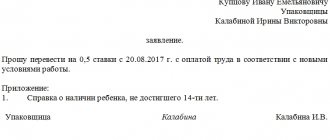Split working day: legal principles of the concept
A person's working day should not exceed 8 hours. The total weekly duration is at least 41 hours. But what to do if for some categories of employees the main activity is carried out for 2-3 hours, then he is forced to remain idle, waiting for the next order, client or something else. This is a typical situation for the application of Article 105, which must be applied:
- if such a work schedule is introduced;
- establishing a maximum time defined as working time.
Labor legislation provides detailed explanations and grounds for when such actions can be taken. If such a situation occurs, then the employer is not prohibited from using this article. It roughly looks like this: If the working day is divided into two time periods, between which there is a lunch break (at least 2 hours), then the use of such schedules is inappropriate. If the break is more than two hours, you can use a broken work schedule. This is exactly how the labor code explains it.
Important! A split day cannot be considered shift work. This is regulated only by internal regulations.
And if the order states that the day is considered divided, then so it will be. For shift work, there is a different order that clearly defines the time frame for each shift. This should not be confused, although many of my friends do not see much of a difference.
The video below shows the peculiarities of regulating discontinuous schedules in labor legislation:
Dividing the working day into parts according to the Labor Code of the Russian Federation
Working conditions are divided by time into shifting, flexible, regular, sliding and fragmented. Each has its own characteristics and nuances . The Labor Code of the Russian Federation controls the parties to comply with all conditions. The fragmented schedule is regulated by Article 105 of the Labor Code of the Russian Federation.
There are a sufficient number of professions and specialties in which the intensity of performing direct duties during the day or shift differs significantly from the standard regime.
In addition, the manufactured product of a number of organizations/companies involves labor of workers that differs from the usual one. This results in health hazards or severe physical manipulation. In these cases, it is necessary to split the shift into several parts .
Article 105 of the Labor Code of the Russian Federation regulates this issue. When dividing a work shift into parts, the total number of working hours is also taken into account. It must remain within the limits provided by law and company regulations.
Conditions and procedure for registration
Any organization has a trade union or other bodies that represent and defend the interests of employees. Based on an appeal to them, an internal local order is prepared for the immediate employer to divide the working day into parts . It is negotiated by both parties to the labor relationship. Changes to the schedule must be immediately included in employment contracts.
Required conditions for registration:
- Circumstances in which fulfilling one’s official obligations is impossible or extremely difficult. For example, specialists in the catering industry. School cooks begin their duties early in the morning. By the start of school, baked goods, etc. should already be ready. Later, the educational institution does not need these resources, or after a few hours. The same thing happens with commercial cleaners. They cannot work while company employees are active. They need to do their work early in the morning or in the evening, after all the employees have left.
- Varying intensity throughout the day. For example, there is a lot of work only during lunch. The employer does not want to pay for mornings and evenings. And in this case, an act of dividing the shift into parts is drawn up.
Working hours regulations
According to the law, the number of working hours per day, week, month should not exceed the norms and standards established by the state. This is precisely the main criterion when dividing the day into several intervals.
Moreover, every organization has regulations with precisely established breaks for rest and work . The latter refers to the time that the employee spends at his own discretion. There are several types :
- vacation;
- holidays;
- time between working parts;
- daily rest;
- rest on weekends.
During a work shift, rest can be divided into heating, nutrition, technological breaks, breastfeeding, etc.
The labor regime is a mandatory part of the employment contract (Article 57 of the Labor Code of the Russian Federation). Control over the splitting of the shift is carried out by Art. 105 Labor Code of the Russian Federation. It controls and determines the conditions under which the manager (employer) can transfer an employee to a fragmented workday mode, determines the establishment procedure and standards.
Different intensity of work during a shift implies a variable work schedule . This is suitable for flight personnel, communications specialists, doctors and bus drivers (intercity and often city).
The regime involves dividing the working day into 2 parts . In this case, the total number of hours does not exceed 10. A break of 2 hours is provided between parts. 30% is provided for this .
Payment, additional payments and compensations
Splitting the working day leads to a number of inconveniences . Workers are often forced to go home and return again, losing time and energy during this period. This mode comes at an additional cost.
Compensation is not included in the salary; it is determined by agreement with the manager. Information and terms of payment are controlled by law and the trade union. The categories of workers who are required to receive additional payment for dividing the working day into parts include the following :
- heads of railway departments - no more than 30% of wages;
- housing and communal services specialists, craftsmen, artisans - more than 30%;
- female workers in rural areas who work in split shifts and have breaks of more than 2 hours - 30% of the salary.
If categories of citizens that fit the description do not receive additional payments, and there are no local acts of compensation at work, the employee can contact the state labor inspectorate to defend his rights.
According to the Labor Code of the Russian Federation, the employer has the right to determine the internal regulations of employees, working conditions and the number of intervals when splitting a shift into parts. According to the law, only in rare cases can breaks for rest and meals be paid; in other cases this is not provided.
Part 1 of Article 108 of the Labor Code of the Russian Federation says that all specialists whose working day is divided into parts have the mandatory right to take a meal break. This period is set by the employer during any shift period and is equal to 30-120 minutes, depending on the enterprise and working conditions. Meal time is also not paid.
There are also paid breaks. This is indicated in Part 2 of Article 108 of the Labor Code of the Russian Federation. Workers who work in cold air or places hazardous to health must periodically warm up and rest during working hours. The employer is obliged to pay for such breaks and provide conditions for proper rest.
Documenting
The registration process consists of several parts :
- Development of an internal document - LNA. It is regulated by several articles of the Labor Code of the Russian Federation - Part 1 of Art. 8, paragraph 7, part 1, art. 22, art. 105. The document represents a regulatory annex, a section of rules or a separate act included in the employment contract. It includes specific numbers, conditions, duration and schedule of the work shift splitting regime: the number of these “pieces”, the exact time of the start and end of the break, duration, amounts of additional pay and compensation, place for rest and time allocated for it, number of unpaid parts of work days, categories and positions of employees who will have division, other additional conditions.
- The LNA project must receive the approval of the Trade Union Committee. A covering letter is drawn up, which indicates the reasons and motives for dividing the shift into several stages, as well as the timing of the response, which asks for an objective opinion on this matter. Within 5 working days, the Trade Union must send its decision. They can make amendments, challenge the entire LNA, hold a meeting and consultation with the employer. If there is no response from the Trade Union Committee within this period, the project is automatically approved in its original form.
- Approval by the director/manager/heads of the organization. The project, certified by the Trade Union Committee, reaches the employer's desk. He puts the stamp “I approve” indicating his initials, position, date and signature. Another way is an order putting the LNA into effect.
- The last stage is documents supplementing the LNA - additional agreements to the employment contract. After new or existing employees have become familiar with the terms of time sharing, work and rest schedules, additional payments and other nuances are discussed and documented.
An example for production, bus, metro and electric transport drivers
Article 105 of the Labor Code of the Russian Federation most often applies to persons serving the population: communications workers, public catering workers, bus, tram, trolleybus drivers, conductors, salespeople and trade managers, housing and communal services specialists and others.
Working conditionsLegislative framework Division into parts
| Production | Engineers, technicians, senior technicians, electricians, chemists and other professionals have intermittent work schedules. | Article 105 of the Labor Code of the Russian Federation. | Employees should not work more than the prescribed standards. |
| Bus drivers | Drivers of regular intercity vehicles are required to work exactly according to the established schedule. If you count all the flights and intervals, you will get a schedule that exceeds the 40-hour norm. | Articles 101 and 99 of the Labor Code of the Russian Federation prohibit irregular days and overtime hours from exceeding the established 120 hours per year. The division into parts of the work shift is guided by Art. 105 Labor Code of the Russian Federation. | The break between units is no more than two hours (exceptions with relevant local regulations), the first period of free time is no later than 5 hours after the start of the shift, any break should not be less than 15 minutes. |
| Drivers of electric vehicles | Subway drivers, trolleybus and tram drivers, locomotive crew workers follow a clearly established time schedule for the movement of vehicles. | Orders of the Ministry of Transport of the Russian Federation No. 63 and No. 127. | A rest room must be provided, food must be included, the break is a maximum of 2 hours during the day and from 2.5 to 6 hours at night. The first break is provided no later than 4 hours after the start of the work shift. |
Taxation of surcharges
A non-standard solution regarding working hours implies additional payments . Article 149 of the Labor Code of the Russian Federation clearly speaks about this. The funds received are controlled by official documents: legislation, labor acts, labor law norms, an agreement with the Trade Union or other team. All additional payments are regulated by taxation, namely:
- are taken into account with the total amount of income and are taxed for individuals, as stated in Articles 209 and 210 of the Tax Code of the Russian Federation;
- Of the compensation, part of the funds is necessarily spent on insurance against injuries, diseases and accidents that are directly related to the specifics of work activity;
- There are deductions to the Social Insurance Fund, the Pension Fund of the Russian Federation, and the Federal Compulsory Medical Insurance Fund.
Source: https://znaybiz.ru/kadry/rezhim/rabochee-vremya/razdelenie-na-chasti.html
Situations when it is necessary to divide the working day
During one working day, the intensity of work may change. For example, in the morning there is so much work that there is no time to even sit down. But as lunch approaches, there are fewer orders, calls, and other things. It’s one thing when employees just sit and do nothing, counting down the time until the end of the working day. And it’s completely different when they go home for a few hours and go to work at a time when the amount of work will increase significantly.
This cannot be a random fact. This should happen all the time. This is the only way to implement a discontinuous schedule. Typically, such situations arise in transport companies, in public utilities, among employees of aviation companies, on the railway, and so on. Therefore, the TC article precisely specifies the prerequisites for the introduction of a discontinuous schedule:
- specifics of activity;
- work of varying intensity, which changes throughout the day;
- the company has a special resolution adopted by the trade union;
- inability to carry out duties from a large number of people (for example, a cleaner in an office, in a bank branch, in a store, and so on).
The employer has the right to divide the working day by hours at his own discretion. But in the event of a dispute, the employer must provide evidence that such actions were aimed at improving the working conditions of employees.
What is flexible work schedule?
A flexible work schedule is the ability to perform your duties at different times of the day. The Labor Code of the Russian Federation (Article 102) regulates that the start and end times of work, as well as its total duration, are determined by agreement between the manager and the subordinate.
If some employees are required to come to the office at a strictly defined time, then adherents of the free regime can afford to come when they need it, but with certain restrictions. This is very convenient for those whose activities are not tied to the office and do not need constant control from their superiors.
Free working mode
What does flexible work schedule mean? As we said above, a floating mode, where there is no clear time frame, is often allowed by representatives of various creative professions. For example, this schedule is preferred by freelance and full-time journalists, photographers, designers, and actors.
In addition to them, realtors who view apartments during the day, sales and advertising managers, or specialized doctors who are called for specific operations or examinations have relative freedom.
This schedule does not imply increased pay, but exceptions are possible by agreement with management.
Flexible work schedule is:
- several long breaks during the day;
- standard hours worked - at least 40;
- the ability to independently organize your work and combine different professions.
Such employees are subject to all labor legislation requirements. Because they are full-time employees, they are entitled to the same benefits as regular employees.
An individual work schedule is not one hundred percent freedom, and in this case certain rules are established.
The employee must still fulfill the required norm, appear at the workplace at the mandatory hours specified in the contract, and also report on what stages a particular project or task is at.
In other words, a freelancer, a homeworker and a flexible worker are not the same thing.
The preparation and implementation of a work plan often occurs with the active participation of management, which sets certain tasks for the employee.
For example, if an advertising manager is faced with the task of concluding a lucrative contract with a large company, then he can work on this in the office or outside it (holding meetings, presentations, negotiations), and no one will fire him for absenteeism or violation of labor discipline.
Types of charts
According to the Labor Code of the Russian Federation, a sliding schedule is considered one of the options for a flexible regime. It is approved by order and may have the following sequence:
- work for a couple of days for the usual 8 hours, then 2 full days off;
- the next stage is 3 working days and the same number of days off, etc.
This mode should not be confused with shift work, where different groups of workers replace each other for a certain period of time. Informing about the transfer to a new rotating schedule is not necessary, unlike the transition to shift work.
The employee has the right to count on:
- full salary;
- vacation, payment for newsletter;
- disability payments;
- weekly rest of at least 42 hours;
- maternity leave;
- food break (at least half an hour);
- benefits and compensation upon dismissal (in some cases).
How to create a flexible work schedule? A sample of this document can be found and downloaded on our website. The schedule component keeps a summary record of working time so that the employee can fulfill the required norm of 40 hours a week or incomplete, for example 24 hours.
Overtime and work on holidays or weekends are also possible, but with mandatory compensation.
Weekends are distributed evenly so that all employees can have a normal rest of at least 42 hours a week.
There is no obligation to notify the employee about the transition to a different work schedule at least a month in advance, but the new rules will still have to be brought to his attention.
A broken work day
In addition, there is a discontinuous work schedule, which is not reflected in labor legislation. We are talking about a working day, as if broken into parts. This possibility is provided for in Art. 105 of the Labor Code of the Russian Federation, but the concept of “break schedule” does not exist in the code.
Breaks are practiced among:
- communications officers, pilots;
- bus drivers;
- taxi drivers, supermarket employees;
- doctors and nurses.
When dividing, the total length of the day should not exceed the norm. The rupture occurs on the basis of an order from management in the case of particularly intensive work or under other circumstances.
When making this decision, the opinion of the trade union may be taken into account. The total length of the day for them should not exceed 10 hours of work. There is also a different payment procedure for such work - 30% higher than the salary.
If the shifts fall at night, then payments are also made at an increased rate.
In addition to sliding and discontinuous, there is also a completely free schedule, when an employee actually works as a freelancer. Then the employee may not come to the office, although an employment or civil contract has been concluded with him for the provision of services (website development, advertising layouts, etc.).
Naturally, such conditions are agreed upon in advance. Remuneration is also discussed individually and depends on the complexity of the project and the time spent on it (usually it is not increased).
Remote work should not be confused with a flexible mode, because the latter still requires the employee to be in the office every day. And the time spent at your workplace is then strictly regulated.
Free 24/7 legal support by phone:
Moscow, St. Petersburg, Russian Federation 8 (800) 350-83-46 (free call)
Features of such breaks
The break between working hours is not paid. The employee receives payment only for the time actually worked. But there are professions where breaks are not comparable to the length of the working day. It can be:
- employees of airlines, railways, bus drivers, whose working day can be much more than 8 hours;
- subway employees;
- educators, teachers, nannies of child care institutions working around the clock;
- veterinarians and livestock farm employees;
- specialists who maintain electrical networks or other utility lines.
An unexpected call to work, as well as long overtime periods, place a strain on the human body and are a gross violation of labor legislation. But in order to officially change the work schedule, the manager must obtain consent from the trade union. And if such an organization does not exist at the enterprise, it is necessary to make decisions taking into account the opinion of the majority of workers.
Break schedule
https://youtu.be/MlPCKAkmsbE
- Should an employer pay for travel during a broken work schedule?
- The employee has irregular working hours. Can I give an additional payment for a discontinuous schedule?
- If they transfer to a discontinuous schedule, what is the additional payment?
- Please, how can I create a new working mode with a discontinuous schedule? Thank you!
If you find it difficult to formulate a question, call, a lawyer will help you: Free from mobile and landline Free multi-channel telephone If you find it difficult to formulate a question, call a free multi-channel telephone, a lawyer will help you 1. If they transfer to a discontinuous schedule, what is the additional payment?
1.1. Good afternoon, Svetlana! If you are transferred to a different work schedule, then there will not necessarily be an additional payment; there should be an additional agreement about this to the employment contract, in which, incl.
The surcharge, if any, must be indicated. 2. The employee has irregular working hours.
How to determine time for lunch
Persons whose working hours are split are not deprived of the right to a legal lunch. It is taken into account in the time period that is formed between going to work. The duration of such lunch breaks should not be less than 30 minutes and no more than 2 hours. The same time can be included in working hours.
Drivers' work schedule according to the Labor Code
In this case, the manager and employee must come to an agreement with each other.
Article 11 of the Labor Code of the Russian Federation states that every employee has the right to receive a day off. If the week is five days, then there will be two days off. With a six-day schedule, at least one day off is required. If summarized accounting is used, then the rest time is set individually. The main thing is that there are no fewer days off than full weeks in a month. To engage a driver to work on a day off, it is necessary to issue a separate order and obtain separate consent from the other party.
You should not leave aside the annual vacation paid by management. In this case, they rely on general legislative norms and give the standard 18 days for rest, no less. The working conditions of many drivers are harmful and dangerous, which contributes to the emergence of the right to additional rest time.
ABOUT LONG WORKING DAYS
A 40-hour work week is the norm in most professions. This applies to any categories of employees, including those who drive buses.
A five-day week requires eight-hour shifts, while a six-day week requires seven-hour shifts. But there are exceptions to any rule. Irregular working days are also possible if absolutely necessary. The regime is established on the basis of data on the normal length of the working week. Rest for each week is issued based on general provisions.
Personal drivers often work irregular hours. Their leaders forget that such behavior is possible, but not systematically, and decisions of this type are made only from time to time. In addition, the presence of serious reasons due to production conditions is important.
The condition for an irregular day may be contained in the employment contract itself. A local regulatory act of an organization should generally separately list those for whom such days are possible.
Drivers with irregular schedules can be assigned additional duties both before and after work. In this mode, consent from the other party is not required. Such employees appear at their place at the same time as the rest and leave the place no earlier than the end of their duties. They are subject to separate rules specified in local regulations.
If irregular working days have become systematic, then the inspection authorities may consider them as overtime.
What are additional types of compensation for? Such employees can also count on receiving additional paid leave every year.
ABOUT THE PROCEDURE FOR MAKING SUMMARY ACCOUNTING
The reason for using summarized accounting is the impossibility of using a standard schedule intended for representatives of a particular profession. Most often, in such situations, accounting periods are set at one month.
Internal labor regulations regulate the very organization of summarized time recording at a particular enterprise. These rules are set personally by the manager. This is done when approving a collective labor agreement, or with mandatory consideration of the opinion of representatives of the trade union body. In the internal regulations, it is necessary to write about the reason why summarized time tracking is organized.
Be sure to indicate the length of the accounting period. Accounting periods can be up to six months if we are talking about work performed seasonally.
Employees must be familiarized with the internal rules when they are hired at an enterprise that operates using summarized accounting. Sometimes summarized accounting becomes individual. This means that it is not valid for everyone, but for certain categories of employees.
ABOUT OTHER FEATURES OF REGISTRATION OF SUMMARY ACCOUNTING
The manager’s order is needed in order to separately establish a shift schedule. It is unacceptable when the length of the working day violates the norm established in one direction or another. At the same time, it is unacceptable for the same employee to work two shifts in a row.
The shift schedule is generated using the form that is used for time sheets. We are talking about standardized forms T-12 or T-13.
These documents have columns that are designated by numbers from 1 to 6. To them, in the case of drivers, you need to add another one, in which each employee signs. This way they will confirm that they are familiar with the rules and the documents themselves.
If the regime is shift work, then rest time is often presented with a so-called sliding schedule. The following parameters are expected to be set when using summarized accounting:
1. Schedule.
2. Norm of working hours in the accounting period.
3. Length of the accounting period.
When accounting is carried out in total, overtime work is determined depending on the hours that fall outside the reporting period. If the mode is normal, it is considered that overtime is the performance of additional duties outside the normal schedule at the initiative of the manager.
ABOUT DAILY ACCOUNTING AND DIVISION
This scheme assumes that the driver works a standard time of 40 hours in one week. The rules are standard, and have been described above more than once. Registration is carried out using standardized forms.
Some drivers have working hours divided into two parts. In this case, no more than five hours should pass after the start of the usual performance of duties before the appointment of rest. A maximum break can last three hours. Rest and food are not included in this period.
The law says that in work related to driving vehicles, part-time work becomes an unacceptable scheme. But some drivers can have irregular working days. It is imperative to take into account the opinion of those who represent the trade union elected body. Employers must only provide safe working conditions that do not have an additional negative impact on the life and health of subordinates.
Is there an additional payment for a less convenient schedule?
Splitting the workday is not entirely convenient for many employees. For example, a janitor goes to work early in the morning, and makes a second exit in the evening. Or an office cleaner who prepares the room before the work day and cleans it after all the employees leave. But this mode is inconvenient for everyone. Many people say that this gives them a lot of free time for household chores.
But most agree that it is inconvenient. Therefore, the law provides for additional payment for such working conditions. It is not even considered an additional payment, but compensation, and the amount is calculated as a percentage of the rate. For some categories it looks like this:
- senior employees at the railway – 30%;
- housing and communal services personnel – 30%;
- women working in rural areas (mainly milkmaids) – 30%.
This is a standard compensation indicator, which can be changed in both directions at the discretion of the employer. The amount of compensation and its percentage must be noted in internal regulations and orders.
Features of recording working hours of car drivers
Payment Methods? Question: How is a broken working day (lunch – 3 hours) paid? (Informational Considering that the Labor Code of the Russian Federation does not indicate the number of parts that may be.
The commented article provides for the possibility of dividing the working day into parts.
Such a division is possible in those jobs where the intensity of work during the working day of the shift is not the same, as well as in jobs with a special nature of work.
The condition for such a division is compliance with the total duration of the working day: the sum of the parts should not exceed the established normal working hours.
Thus, housing and communal services workers, for example, janitors, work in the early morning and evening; public transport workers are unevenly loaded throughout the day, etc.
The Labor Code of the Russian Federation does not determine how many parts a working day can be divided into and how long it should be.
In practice, most often the working day is divided into two payments, breaking the working day according to the labor code, with a break between them of more than two hours. However, there may be parts of the working day.
The specified break also includes a break for rest and food.
The division of the working day into parts is introduced by a local regulatory act of the employer, taking into account the opinion of the elected body of the primary trade union organization.
A local regulatory act must provide for the circle of workers for whom the division of the working day into parts, the number of specified parts, and the start and end time of each part of working time are established.
Industry tariff agreements, collective agreements or local regulations of the employer may provide for additional payments to employees for the inconvenience caused by dividing the working day into parts.
Such surcharges are provided for, in particular, by the Industry Tariff Agreement in the housing and communal services of the Russian Federation for - years, approved by Rosstroi. Similar norms are established in clause.
What is a division of the working day?
Moreover, the establishment of such an additional payment by agreement of the parties to the social partnership may be determined not only by the work schedule, but also by the category of labor codes. According to clause
In the case where the surcharge is established at the level of social partnership, employers who have acceded to the Agreement are required to pay the surcharge in accordance with the terms of the relevant Agreement. By order of the Ministry of Education and Science of Russia dated In accordance with paragraph.
The break time between two parts of a shift is not included in working hours.
The plaintiffs work at a boarding school in a labor code position. In the collective agreement of the boarding school, concluded for the period from July 4.
Industry agreement between the Department of Education and Science and the regional organization of the Trade Union of Public Education and Science Workers of the Russian Federation for the years. The court came to the conclusion that the plaintiffs’ work is discontinuous in nature, and therefore the arrears of wages for the discontinuous nature of the work must be recovered.
For certain categories of workers, the division of the working day into parts is provided for by regulations. For example, clause. The division is made by the employer on the basis of a local regulatory act adopted taking into account the opinion of the relevant elected trade union body.
When does it make sense to split your workday?
The break between the two parts of the shift's working day is established no later than four hours after the start of work.
The duration of the break between parts of the working day of a shift when dividing the working day of a shift into parts in the daytime should be no more than two hours according to the time code for rest and food, at night - no more than six hours excluding time for rest and food, and the total duration The daily work of the shift should not exceed the duration of the daily work of the shift established by clause.
A break between two parts of a shift is provided in a place equipped for drivers’ rest. The break time between two parts of the working day of a shift is not included in working hours.
In this case, one break lasting more than two hours or two breaks lasting at least one hour is established. The specified breaks include the break time for days and meals.
The total duration of working hours per working day of a shift should not exceed the duration of the daily work of a shift established for a specific category of employees by the internal labor regulations of the organization.
Break time between parts of a shift is not included in working hours. The procedure and place for providing these breaks are established by the organization’s labor regulations; the time of provision and the specific duration of these breaks are established by shift schedules.
Thus, the court indicated that, on the basis of the director’s order, the work of conductors began on April 9. All conductors, including the plaintiffs, were familiar with the order, which is confirmed by their signatures. In accordance with the spring-summer schedule, the trams on the plaintiffs’ work route on weekends are given two breaks lasting less than two hours during the shift.
Since the regulations on the remuneration of conductors provide for additional payment for work with the division of the working day into parts, if the break between them is at least two hours, the court’s conclusion about the legality of the actions of the employer who stopped paying the specified additional payment on those days when the break was less than two hours , is justified, since the specified additional payment is of a compensatory nature.
and get a free consultation within 5 minutes
In those shifts when the plaintiffs’ breaks in work exceeded two hours, additional payments were made, which is confirmed by the pay slips available in the case materials. The court noted that s.
The division is made by the employer on the basis of a local regulatory act adopted taking into account the opinion of the representative body of employees.
The break between the two parts of the working day is established no later than four hours after the start of work.
The duration of the break between two parts of the working day should be no more than two hours, excluding time for rest and food, and the total duration of the daily work of the shift should not exceed the duration of the daily work of the shift established by clause.
Please provide your contact information so that we can contact you.
The break between the two parts of the shift is provided at the location or place designated for the parking of buses and equipped for driver rest.
The fact of establishing a break between two parts of the working day on the route Syktyvkar - Ukhta of five hours and 15 minutes and determining the duration of such a break in the amount of five hours 50 pay breaks working day labor code is confirmed by the bus schedule and is not disputed by society.
Source: https://otvety911.ru/biznes/oplata-razrivnoy-rabochiy-den-trudovoy-kodeks.html
If the amount of compensation is deliberately underestimated
This situation is a gross violation of the law. If an employee believes that the head of the enterprise has illegally underestimated the amount of compensation payments, he needs to write a statement and submit it to the inspectorate for the protection of workers' rights or GIT (State Labor Inspectorate). The complaint will definitely be accepted, and the employer will receive an official notification.
If the manager does not consider it necessary to correct the situation in the near future, then a thorough check is carried out and, if the facts are confirmed, he faces:
- a fine of 1 to 5 thousand rubles for government officials;
- legal entities will have to part with large sums - from 30 to 50 thousand rubles.
If amendments are made to the Government resolution, the amount of fines may change, but not less. Such proceedings do not deprive the employee of the opportunity to continue his work. If the manager does not blurt out the missing amount of compensation, you can safely go to court. There is already a smell of infringement of rights and discrimination here, and I am ready to provide legal support in resolving such a dispute.
The employee has the right to demand not only the amount of underpaid compensation, but also a certain day for moral damage. Dealing with this on your own is quite difficult.
What is the wage for a broken working day according to the Labor Code of the Russian Federation with comments
Info
Having considered the complaint, the State Labor Inspectorate may issue an order to eliminate violations of labor legislation, which are binding on the employer (Article 356, paragraph 6, part 1, Article 357 of the Labor Code of the Russian Federation). Based on the results of the inspection, the employer may be held administratively liable for violating labor laws. Officials face an administrative fine of 1,000 rubles or more.
up to 5,000 rubles, legal entities - from 30,000 rubles. up to 50,000 rub. (Part 1 of Article 5.27 of the Code of Administrative Offenses of the Russian Federation).
In practice, a situation occurs, which prompted the writing of this article, when an employer, wanting to divide the working day into several parts, sets the time between parts to less than 2 hours, which entails the formal absence of a divided working day and, as a consequence, additional payment for this time. Unfortunately, this situation is not regulated by law and remains on the conscience of the employer.
How does separation occur?
The employer understands that some vacancies at his company require a split working day. But he doesn’t quite understand how to do it correctly. A certain procedure will help you undergo the procedure painlessly:
- develop a normative act specifying the distribution procedure;
- sending the document to the trade union committee;
- internal affirmation;
- familiarization with the document of the employees in respect of whose activities this was done;
- concluding an additional agreement with the employee.
These are necessary actions that will protect a person from violations on his part by the employer. The trade union is conducting a check to see how the standards specified in the announcement are being observed.
What is the wage for a broken working day according to the Labor Code of the Russian Federation?
After the union reviews the project, a decision is made.
- Approval of the document, its official publication.
- Providing subordinates with the opportunity to familiarize themselves with the document, receiving their signature as proof of the implementation of the specified action. Also, if necessary, the details and details of the new regime should be explained to employees.
- Drawing up additional agreements with subordinates. This document is intended to record the divided work schedule in relation to each employee in particular.
Thus, the employer does not have the right to unilaterally decide on the use of such a labor regime.
Another comment on Art. 105 Labor Code of the Russian Federation
1. Article 105 of the Labor Code of the Russian Federation establishes both the conditions for the application of a work regime with the division of the working day into parts, and the procedure for introducing such a regime.
2. The conditions for applying the work regime with the division of the working day into parts are the special nature of the work or the performance of work, the intensity of which is not the same during the working day (shift). Schedules dividing the working day into parts are used mainly in organizations serving the population, for example, for drivers of urban passenger transport, for some trade workers.
3. The Labor Code does not determine the duration of either individual parts of the working day or breaks between them. These issues should be resolved by a local regulatory act on the introduction of a division of the working day into parts, adopted taking into account the opinion of the elected body of the primary trade union organization. At the same time, the total duration of a working day (shift) should not exceed the duration of daily work established for employees by internal labor regulations or an employment contract.
Vote:
This article and other articles of the Labor Code of the Russian Federation do not say anything about the premium for such a fragmented day. This premium is established either by a by-law normative legal act regulating the characteristics of the labor of certain categories of workers, or by a collective agreement or other local normative act - at the discretion of the employer or at the proposal of the trade union. Order of the Ministry of Communications of September 8, 2003 N 112 “On approval of the Regulations on the peculiarities of working hours and rest time for communication workers with a special nature of work” established that employees directly related to serving the population, as well as when performing work, the intensity of which is unequal during a working day (shift), a working day divided into parts may be established in the manner established by Article 105 of the Labor Code of the Russian Federation. A working day divided into parts can be established, inter alia, for telecom operators for receiving and issuing postal items and telegrams, as well as for organizing mail delivery, telecom operators receiving and issuing money and other valuables at the main cash desk of a postal service delivery institution, operators connections of subscriber sites. As for the amount of the surcharge, we were unable to find any regulations of the Ministry of Communications or the Government of the Russian Federation. We recommend that you contact the industry trade union for clarification, since they know the specifics better (at least they should provide a link to the regulatory or local act that provides for the allowance you are interested in).
“Advisor in the field of education”, 2007, N 3
Question: Our institution is in the process of concluding a collective agreement. We want to provide additional leave for employees with irregular working hours, since we believe that the majority of our employees have irregular working hours. But the administration believes that these workers have a “discontinuous nature of work,” therefore, they are not entitled to additional leave. Please explain the difference between irregular working hours and discontinuous work.
Answer: The discontinuous nature of labor is regulated by Art. 105 of the Labor Code of the Russian Federation, which is called “Dividing the working day into parts.”
According to this article, dividing the working day into parts is possible:
- when performing work, the intensity of which is not the same throughout the working day;
- if the working day is divided in such a way that the total working time does not exceed the established duration of daily work;
- if the division of work is carried out only on the basis of a local regulatory act adopted taking into account the opinion of the elected trade union body.
The main differences between an irregular working day and a working day divided into parts are as follows. An employee with irregular working hours is involved in work outside the normal working hours sporadically, while an employee whose working day is divided into parts works systematically within this working hours.









